|
Cetacea (whales, dolphins and
porpoises)
Life
>
Eukaryotes >
Opisthokonta >
Metazoa (animals) > Bilateria > Deuterostomia >
Chordata > Craniata > Vertebrata (vertebrates) >
Gnathostomata (jawed vertebrates) > Teleostomi (teleost
fish) > Osteichthyes (bony fish) > Class:
Sarcopterygii (lobe-finned fish) > Stegocephalia
(terrestrial vertebrates) > Reptiliomorpha > Amniota >
Synapsida (mammal-like reptiles) > Therapsida > Theriodontia
> Cynodontia > Mammalia (mammals)
> Placentalia (placental mammals) >
Laurasiatheria > Ferungulata > Cetartiodactyla (even-toed ungulates and cetaceans)
> Whippomorpha
Introduction
The cetaceans (whales and dolphins), are the
largest and most diverse order of marine mammals and previously were
divided into two
suborders, the Odontoceti (toothed whales) and the Mysteceti (baleen
or rorqual whales), which are separated primarily on the basis of
feeding strategies and accompanying morphological transformations.
As the Mysteceti are believed to have evolved from an Odontoceti
ancestor, the Odontoceti is a paraphyletic group. Hence, in the
classification presented here, we have dispensed with this division
of the Cetacea. Nevertheless the two groups are discussed below in
the context of their differing morphology and biology.
A characteristic of most modern toothed whales is the development of
a high frequency echolocating system which primitive toothed whales
(such as the archeocete or ‘archaic whale’), probably did not
possess. Baleen whales do emit sounds, but they have a cochlea (ear
bone), developed for the perception of low frequency sounds, making
it appear doubtful that echolocation, which typically uses high
frequency sounds, is utilized in the feeding strategy of filter
feeding whales.
Baleen whales have evolved a filter-feeding system consisting of
fibrous baleen plates in the place of teeth. They are surface
feeders, feeding mainly on zoo-plankton, which are harvested mostly
in the upper 100metres. The toothed whale strategy is to focus on more discrete forms
of prey, such as squid and fish, hence their development of an
echolocating system that assists them to locate and hunt such prey
in poor visibility or at great depths. A good example of this
feeding strategy is the sperm whale which has been know to sound
(dive), to over 1000 and possibly 2250 meters in it’s hunt for
squid. To achieve this, they have also needed to develop
morphological characteristics quite different from the surface
feeding baleen whales, such as relative buoyancy control, that
facilitate energy conservation at great depths.
Palaeontological evidence suggests that both
the echolocating toothed whales and the filter feeding baleen whales
diverged in the early Oligocene (38-31.5 Mya) from a common
archeocete (primitive toothed whale) ancestor, which possessed
neither echolocating nor filter feeding abilities. More
specifically, Fordyce feels that the three major groups of modern
cetaceans which are the toothed whales, the beaked whales and the
baleen whales had a monophyletic point of origin (that is, of
singular ancestral origin), rooted in a group of archaic toothed
whales called the Dorudontinae. As mentioned above, early speciation
of intermediates from this group about 38 to 31.5 million years ago
led to the evolution of modern whales as we know them today.
The presence of embryological dentition appearing before the
development of baleen plates and the discovery of fossilised
intermediates such (such as Aetiocetus) between the Archaeoceti and
the Mysteceti, further provide evidence that the Mysteceti evolved
from a primitive toothed whale.
The extant toothed whales are more diversified than the baleen
whales, with the dolphins (Delphinidae) being the most speciose and,
on the basis of paleontological evidence the family of toothed
whales which radiated most recently.
The earliest ‘archaic whale’ yet discovered is
Pakicetus, a fossil
about 50 million years old from Pakistan. Biochemical and genetic
studies suggest that these early archeocetes themselves evolved from
ungulates (hoofed mammals). These early hoofed mammals gradually
made their way back to a marine habitat from a terrestrial one.
According to Fordyce the most likely ancestral group of early
toothed whales is the Mesonychidae, a family of primitive
terrestrial hoofed mammals that lived in North America, Europe and
Asia, that adapted to fish eating in the shallows of an ancient
ocean basin known as the Tethys which stretched from the present
Mediterranean to beyond India. The closest living ungulate to modern
cetaceans is the hippopotamus.
Molecular study
Deoxyribonucleic acid (DNA) is the molecule that houses the genetic
code. Methods have evolved that enable the researcher to both sample
and analyse the genetic structure, most generally by selecting and
reading gene sequences. The identified genetic sequences are then
converted into numerical data which is statistically analysed to
infer phylogenies (that is, to reconstruct the statistically most
probable evolutionary history of a selected species or group of
species).
Palaeontologists on the other hand, do a comparative analyses of
morphological similarities and differences of fossilised skeletal
material characteristics in their efforts to trace evolutionary
histories.
Today, modern systematists use both the morphological and the
molecular approach to best infer phylogenies. An example of such a
study is included below. This study also well illustrates that
evolutionary histories are inferred probabilities (when considering
an incomplete fossil record as well as limited sampling of the DNA),
and that changes, in the light of new evidence, will be made.
Highly conserved mtDNA sequences of whales and
dolphins - Phlyogenetic Implications:
Sequence divergence values, estimated from the pairwise proportion
of shared restriction sites of mitochondrial DNA (mtDNA), in the
cetacean taxa, are low, reflecting an unexpectantly high
conservation of mtDNA sequences.
This implies that either the rate of nucleotide substitution of
cetacean mtDNA is slower than that of terrestrial mammals, or that
the fossil record of cetaceans needs to be re-interpreted.
For example, fossil evidence suggests that the baleen and toothed
whales evolved from an archeocete common ancestor about 35 million
years ago, which means that the substitution rate for cetacean mtDNA
is about 0.22% per million years, as compared to the terrestrial
mammalian mtDNA rate of 1% per million years – a fourfold difference
in mutation rate between marine and terrestrial mammals. Conversely,
if the calibration of the mammalian mtDNA molecular clock originally
established by Brown et al. is valid for cetaceans, then the low
sequence divergence values indicates a recent and rapid radiation of
the major cetacean groups: the toothed and baleen whales would then
have shared a common ancestor as recently as 7-8 million years ago
(compared to the fossil based estimates of 35 million years ago).
Whether the earlier forms of toothed whales and baleen whales are
directly ancestral to the extant forms, or whether they are possibly
an example of parallel evolution with the extinct forms having
morphological features similar to those of the living suborders,
remains an unresolved issue.
However, when considering these results, it should be noted that it
has been demonstrated (by comparison with complete genomic
sequences), that the sampling method of mtDNA used in this study was
skewed towards the conservative. None the less this bias alone is
not nearly great enough to explain the difference in mutation rates
between marine and terrestrial mammals meaning that the above
argument does hold true.
It is important to note that the relative rate of evolution implied
by this molecular study (Ohland et al 1994), of the groups of
cetaceans sampled is concordant with that of fossil-based studies.
The initial splitting of the baleen and toothed whale lineages is
followed by the divergence of the lineages leading to the sperm and
beaked whale families, with the dolphins being the most recent
family to evolve.
Families found off the coast of southern Africa
|
Physeteridae (Sperm whale)
One species:
Physeter cotodon (Sperm Whale).
|
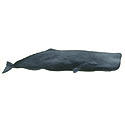 |
|
Kogiidae |
|
|
Ziphiidae (beaked whales) |
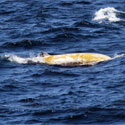 |
|
Delphinidae (dolphins, pilot
whales, killer whales and false killer whales) |
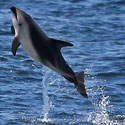 |
|
Balaenidae (right whales) One species
iindigenous to southern Africa: Eubalaena australis (Southern right whale).
This large baleen whale is by far the most common of the whale species found
off the Cape coast. Their social group is normally a
family unit that consists of less than 6 individuals. They can be seen most
prolifically between July and September along the Cape coast, particularly
in False Bay, the Hermarnus area and off the coast opposite de Hoop Nature
Reserve. |
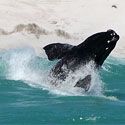 |
|
Neobalaenidae (pygmy right
whales) One species indigenous to southern Africa:
Caperea marginata (Pygmy right whale). This is the smallest of the baleen whales,
having a length of about 5 metres and a weight of around 4 500kg. It
has a small triangular dorsal fin, set back towards the tail, and
has throat grooves. Colouration is a deep blue grey that lightens
towards towards the belly side.
Little is know of these scarcely seen animals. |
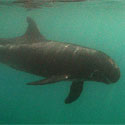 |
|
Balaenidopteridae
(rorquals) |
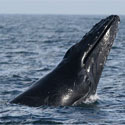 |
Other families,
not encountered off southern Africa: Eschrictiidae (Grey Whale
Eschrichtius robustus) - Pacific), Monodontidae (white whales -
Arctic Ocean), Platanistidae (river dolphins - South America, S and
E Asia).
|
